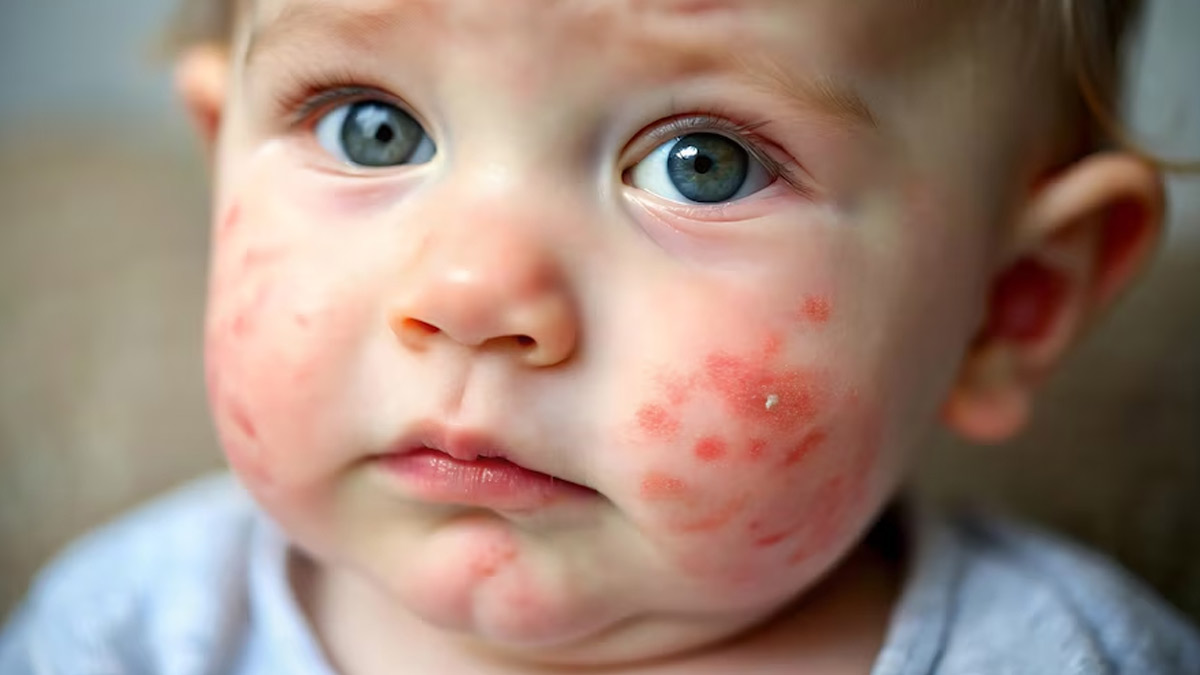
When you have a baby with sensitive skin, the thought of having to manage a condition like Atopic Dermatitis (AD) can be daunting. For high-risk babies, those with a family history of allergic conditions, this chronic skin condition adds an extra layer of discomfort and stress for both baby and caretakers. However, did you know this condition can be managed by emollients? These moisturising creams and lotions do more than add moisture; they restore and strengthen the skin’s barrier, alleviating dryness, itchiness, and inflammation.
Table of Content:-
We spoke to our expert Dr Vinay H Joshi, MBBS, MD, DM (Neonatology) Fellowship NICU, PICU and Cardiac ICU (Australia & Canada), Neonatologist and Paediatric Intensivist Cloudnine Hospital, Mumbai Honorary and Consultant, Wadia Hospital, Mumbai, who explained how emollients work in managing AD and improving your little one’s skin.
What Is Atopic Dermatitis?

"Atopic dermatitis (AD), also known as eczema, is a long-term inflammatory skin condition that frequently appears on sensitive skin. It is characterised by dry, itchy, and inflamed skin and can lead to significant discomfort and potential complications, such as secondary infections," said Dr Joshi.
According to a 2016 study, in approximately 60% of cases, the condition appears within the first year of life (known as early-onset), although it can develop at any age. The initial clinical signs include dry and rough skin, but eczematous lesions typically do not emerge until after the second month of life.
Atopic Dermatitis in Infants

AD frequently occurs in infants and is shaped by a combination of genetic predispositions, environmental factors, and challenges with the skin barrier. "The skin of infants is especially susceptible to irritation due to its ongoing development and incomplete protective capabilities. For those with a tendency toward atopic conditions, this sensitivity is amplified, increasing the risk of developing AD," added Dr Joshi. According to StatPearls, if one parent has atopic conditions, there’s over a 50% chance that their child will develop similar symptoms. When both parents are affected, the likelihood increases to as much as 80%.
Also Read: Do You Have Atopic Dermatitis? Here’s How It Can Put You At Risk Of Food Allergies
Benefits of Emollients

Emollients are lipid-rich products designed to enhance skin moisture and restore the skin's natural barrier. Their functioning can be categorised into three main roles:
Restoring Essential Lipids
"In infants with atopic dermatitis, the skin barrier is frequently compromised because of a lack of essential lipids. Emollients provide these exogenous lipids which help in the restoration of the barrier and reduce susceptibility of the skin to irritants and allergens," said Dr Joshi.
Specialised emollients, particularly those containing colloidal oatmeal, can boost the skin's natural lipids (ceramides), which aid in moisturising and reinforcing the protective moisture barrier of the skin.
Minimising Water Loss
One of the main roles of emollients is to create an occlusive layer on the skin's surface that prevents moisture loss. This barrier helps retain hydration, which is essential for effectively managing AD.
Enhancing Skin Barrier Integrity
"Regular application of emollients has been demonstrated to enhance skin barrier function, particularly in high-risk infants. Maintaining a strong skin barrier is crucial, as it can potentially delay or prevent the onset of AD," added Dr Joshi.
Selecting the Right Emollients for Optimal Skin Health
Understanding Emollient Formulations
According to a 2018 study, specially formulated emollient products may advertise antimicrobial, anti-itch, and anti-inflammatory properties. They consist of complex blends of chemical agents specifically designed to soften and enhance the pliability of the epidermis.
The Benefits of Colloidal Oatmeal
Colloidal oatmeal is particularly significant because it is the only skin-protectant ingredient approved by the US FDA for treating dry, itchy, and sensitive skin prone to atopy.
Key Ingredients to Look For
Emollients formulated with colloidal oatmeal contain beneficial lipids that help repair and fortify the skin barrier. When selecting an emollient, opt for a hypoallergenic lotion or cream that protects your baby's skin from harsh environmental conditions while ensuring it remains soft and smooth.
“Choose products high in avenanthramides, as research suggests these compounds have anti-inflammatory, antioxidant, anti-itch, and anti-irritant effects, providing relief for sensitive skin. A quality emollient not only hydrates but also protects the skin from dryness,” added Dr Joshi.
Also Read: Dealing With Eczema Scars? Expert Lists Its Causes, Treatment, And Prevention Measures
Key Considerations for Effective Emollient Use

Guidelines for Application
Although evidence on prevention remains inconclusive, the importance of emollients in managing AD or eczema is clear. Here are some key recommendations to keep in mind:
Consistent Daily Use
Apply emollients generously at least twice daily, even when the skin looks clear. This consistency is essential for maintaining hydration and supporting the skin barrier, helping to reduce the risk of flare-ups.
Optimal Timing
The timing of the application matters. For best results, use emollients immediately after bathing to lock in moisture and protect against dryness.
Selecting the Right Emollient
Choose products that are clinically proven to be effective for children with eczema. Aim for hypoallergenic formulations that are fragrance-free and suitable for newborns. It’s also beneficial to select emollients containing IAP-recommended ingredients, such as colloidal oatmeal.
[Disclaimer: This article contains information provided by an expert and is for informational purposes only. Hence, we advise you to consult your own professional if you are dealing with any health issues to avoid complications.]
Also watch this video
How we keep this article up to date:
We work with experts and keep a close eye on the latest in health and wellness. Whenever there is a new research or helpful information, we update our articles with accurate and useful advice.
Current Version